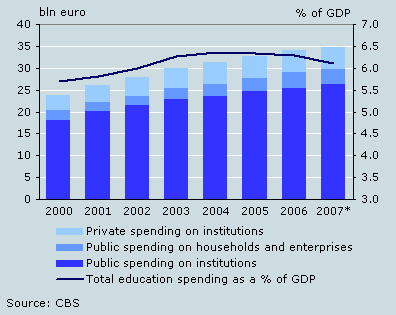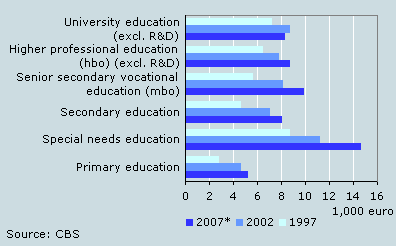Senior secondary vocational students cost more than higher education students

Dutch education spending rose in 2007, but by less than in previous years. Students in senior secondary vocational education (mbo) cost more in recent years than students in higher education. This is the result of increased public and private sector spending.
Education spending accounts for less of GDP
Total spending on education amounted to 34.7 billion euro in the Netherlands in 2007. This is 2.2 percent more than in the previous year. In terms of a percentage of the gross domestic product (GDP), education spending was slightly lower in 2007 than in 2006. One reason for this was that in 2006 300 million euro had been paid in advance to transport companies for the 2007 student travel passes. However, even without this transfer, education spending would have accounted for a smaller part of GDP.
Spending on education

Senior secondary vocational students cost most
Within state subsidised education senior secondary vocational education (mbo) is the most expensive form of further education: spending per student totalled nearly 10 thousand euro. Spending on mbo has been faster to rise in recent years than spending on students in higher education. Since 2002 mbo students have cost more than university students, if spending on research at universities is left out of account.
Both the public and the private sector have put more money into senior secondary vocational education in recent years. The impulse of the private sector lay in making more money available for work placements. In addition the government earmarked money for projects such as improving various aspects of the transition from school to the labour market, and reducing the number of pupils dropping out of school.
Spending per student in state subsidised education

Private sector and households main financiers of further education
In addition to the government, companies and households account for a substantial part of financing of senior secondary vocational education and higher education. Companies are the largest private funders of mbo education. They spend money on the supervision of students in work placements and apprenticeship programmes. In higher professional education (hbo), too, private sector money is spent mainly on supervision. At universities companies pay mainly for contractual research. Spending by households consists mainly of fees paid to education institutions.
Financiers of subsidised institutions in senior secondary vocational education (mbo) and higher education, 2007*

Daniëlle Andarabi-van Klaveren